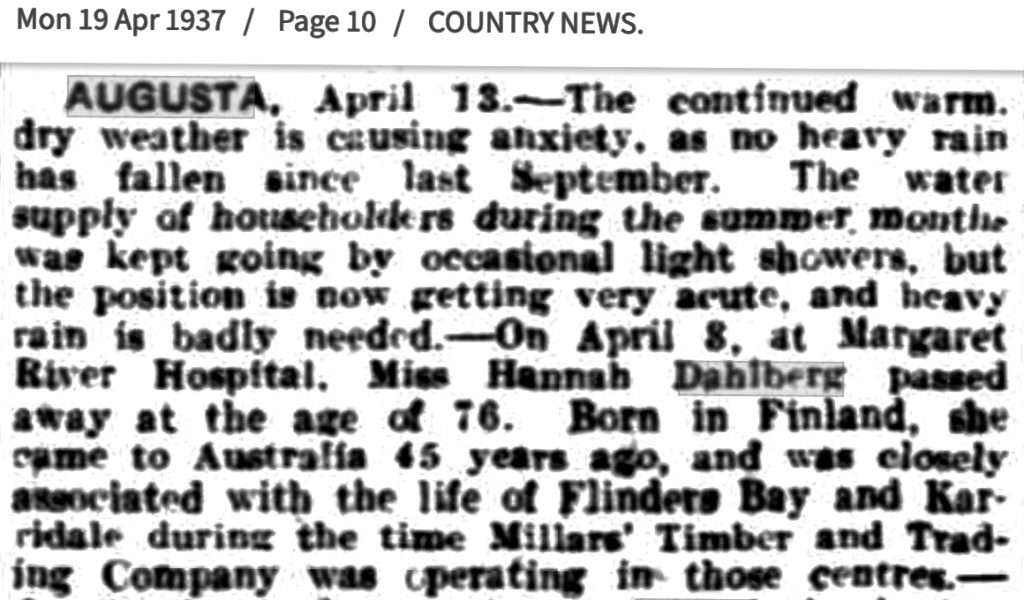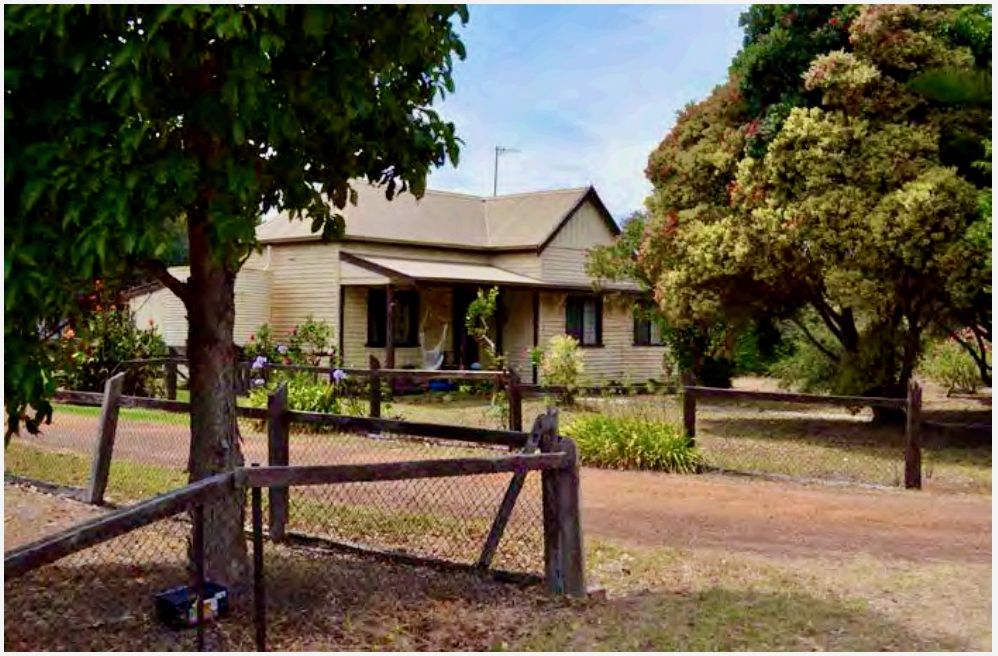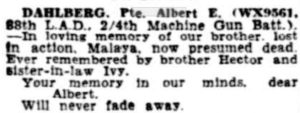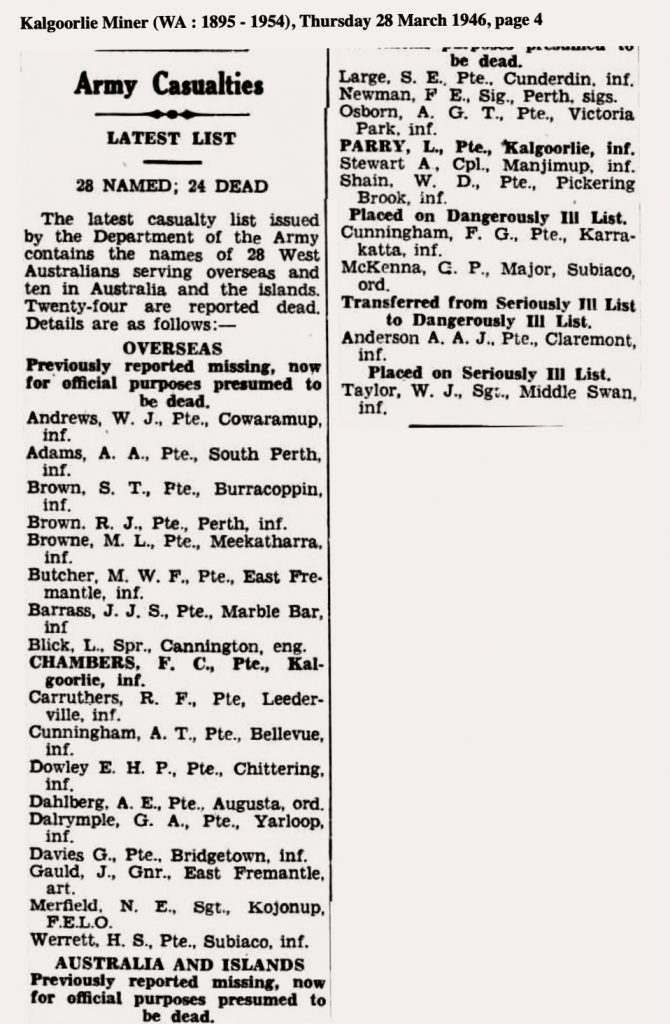The Soldier's Details

- Surname:
- Dahlberg
- First Name:
- Albert Edward
- Rank:
- Corporal
- Regimental #:
- WX9561
- Classification:
- Fitter
- Company:
- Attached 2/4th, 88 Light Aid Detachment
- Enlisted:
- 4.12.1940
- DOB:
- 23.07.1911
- Place of Birth:
- Hamelin Bay, Western Australia
- Father's Name:
- Charles Alexander Dahlberg
- Mothers's Name:
- Beata (Bertha) Dahlberg (nee Long)
- Religion:
- Church of England
- Pre-war Occupation:
- Truck Driver
- Memorial:
- Epitaph, Singapore Memorial, Column 139, Age 30.
- Cause of Death:
- Killed in Action
- Place of Death:
- Reformatory Road, Ulu Pandan
- Date of Death:
- 10.02.1942
General Description
Dahlberg was with 88th LAD attached to the 2/4th MGB.
He enlisted 4 Dec 1940 at Claremont, recording his NOK as his mother, Bertha Dahlberg.
Albert Dahlberg was KIA 10 Feb 1942 during the fighting at Reformatory Road, Ulu Pandan. He was 30 years of age.
Please read about Bertha’s premonition

Augusta WW2 Memorial

Augusta 1830s by Thomas Turner

Albert Edward Dahlberg was the third born of 4 sons -Hector, Charles, Albert and Oscar and 2 daughters Rose and Mildred born to Charles Alexander and Bertha Lang. The Dahlbergs married in 1905 Karridale.
Charles Dahlbo (changed to Dahlberg) was born 31 July 1877, Partann Wasa, Finland came to Australia in his late teen years.
Albert’s mother was born 1875 Portom, Lansi-Suomen Laani, Finland. We believe Bertha came to Australia with her parents.
Charles’ sister Johanna Maria (Hannah) Dahlbo also came to Western Australia from Finland and residing in the Augusta region. Hannah Dahlberg died April 1937.
Below: Hannah’s shipping arrival 1901.

Below: Notice of Hannah Dahlbo’s intention to Naturalize.


Below: ‘Blackwood’ 9 (Lot 219) Bussell Highway, Augusta – the house built in 1926-1927 by Charles Dahlberg for his beloved sister Hannah.

‘Blackwood is a very simple Inter War cottage with a projecting square bay flanked by a front verandah. The walls are clad with square-edged weatherboards, with flat sheet and vertical battens to the gable infill. The gable-hipped roof has been clad with pre-painted corrugated steel sheeting (Colorbond). The original windows have been replaced in an interpretation of traditional timber-framed, small paned glazing, and the house has been extended to the side (south) with a skillion addition (built in two stages). There is also a flat sheet fibrous cement skillion at the rear. The grounds include a gravel driveway along one side (bounded by a timber post and rail fence with woven wire infill) and mature plantings to the front yard (none of which appear to date from the original period of occupation). There is no front fence.’
‘Charles Alexander Dahlberg and his sister Hannah arrived in the southwest of Western Australia in 1894. In the early years Charles was employed by M C Davies Co. (later Millars Timber and Trading Co.) and worked on various constructions jobs in and around the Augusta area.
Some of his jobs included being a maintenance man on the Hamelin Bay jetty, foreman on the Flinders Bay jetty and ganger on the Karridale to Flinders Bay railway line. Charles also worked on the completion of the Flinders Bay junction yards.
Charles Dahlberg was a prominent builder in the area. Other places he built Shire of Augusta-Margaret River Heritage Inventory (July 2012) 128 between 1905 and 1930 include the old newsagent’s store in the centre of town (for W Ellis – general store), the hall next door (since burnt down), ‘Dingle Dell Guest House,’ ‘Callalup’ (his own farmhouse), and the Butchers Shop – all in Augusta, and McCaullay’s store at Witchcliffe. He also did most of the carpentry in Augusta Hotel (1912).

Above: ‘Callallup’ Farm, 222 (Lot 572) Hillview Road, Augusta
The building now known as Callalup farmhouse is believed to have been relocated to this site and adapted as a family home by Charles Dahlberg in approximately 1910 (five years after his marriage to Bertha Long in the Karridale district and following the birth of their first three children). There is some conjecture as to whether the homestead was built from the dismantled small mill hospital from Karridale or the Hamelin Bay Police Station, although Gail Cresswell, in her book The Light of Leeuwin, states that Dahlberg ‘removed the Karridale Hospital and transported it to his farm’ (p 158). There is also some conjecture that this was more likely to have been the original first aid posting building rather than the Karridale Hospital. Charles Dahlberg was listed in the electoral rolls as a ‘farm labourer’ but he also worked locally as a builder. Other places he built between 1905 and 1930 include the old newsagent’s store (for W Ellis – general store), the hall next door (since burnt down), ‘Dingle Dell Guest House,’ the Butcher’s Shop, ‘Idle Time’ and ‘Blackwood’ – all in Augusta – as well as McCaullay’s store in Witchcliffe. He also did most of the carpentry in Augusta Hotel in 1912. In 1921 Dahlberg built a butcher’s shop in the centre of Augusta (which traded as C A Dahlberg & Co, Butcher and Smallgoods Meats) This ceased operating as a butcher’s shop around 1925-26 and Dahlberg later moved his family from their farm ‘Callalup’ to live there.’
‘This single storey residence is set on a slope, which places the rear at ground level and the front verandah approximately 1.7m above ground. The house is raised on timber stumps and is constructed of square edged weatherboards, with a gable-hipped corrugated iron roof. Just below the eaves there are a series of unusual rectangular wall vents framed by simple projecting moulding (possibly providing ventilation for a ‘healthy’ environment in relation to an original use as a medical facility). The gable end is finished with battened flat fibrous cement sheeting (a detail possibly dating from the relocation of the building to this site), and has slatted timber eaves. The main facade features a simple projecting square bay on the LHS, flanked by a small verandah (now without a balustrade and accessed by a temporary ladder). The front door has four panels with moulded detailing, with a fanlight over. The architraves to this and the double hung windows are wide and quite heavily moulded (to both the front and side facades). Adjacent to the front door there is evidence that there was also previously an opening from the verandah directly into the room of the projecting bay. To the side elevation, the double hung window has a pivoting highlight – a detail commensurate with use as a public building rather than a simple farmhouse of the region. This elevation also retains a field stone foundation consistent with a former externally mounted, flat metal sheet fireplace. Limited internal views reveal that the front hallway and at least some of the rooms have timber wainscots with flat wall sheeting over. There appear to be back-to-back fireplaces in the two rooms behind the bay front (with a brick chimney). The central room at the rear retains pressed metal wall cladding. Immediately behind the house there is a detached weatherboard laundry and store, while in the immediate area there are several other small weatherboard, flat sheet fibrous cement, and corrugated iron sheds timber sheds, plus timber fenced stock yards. Larger modern sheds are set further from the house.’
Below: The Butcher’s Shop, Augusta – owned by the Dahlberg family and at one time their home.

All of the above information and photos is from SHIRE OF AUGUSTA-MARGARET RIVER HERITAGE INVENTORY. We wish to acknowledge and thank them for their valuable research.
In 1932 Albert’s father Charles died, he had been working in agriculture, building and other ventures around Augusta for 30 years.


Below: Bertha Dahlberg becomes a Natrualized Australian Citizen 1934.

In 1936 and 1937 Electoral Roll Albert and brother Oscar who was 4 years younger, worked at Hoffmans Mills (27 kms north-east of Harvey).
About the time Albert enlisted, Albert’s mother and some family members were residing at Augusta. In 1941 he was farewelled from Augusta.

The above notice was printed in West Australian’s Country News, July 1941.
In July 1999 Murray Ewen received a letter from a nephew of Albert, Vern Tinley from Augusta. He wrote that he learned that whilst at small family social gathering with Albert’s only living sibling, his brother Oscar with his wife and several close friends that Albert and his sweetheart Mary became engaged before he went to Singapore however decided to keep secret and not tell their families.
Mary, then in her 80’s (1999) was very interested in viewing the families photos including those with Albert and said “I have a lovely photograph of your mother (Vern’s mother) with her brother Albert, and a photo of Albert in uniform before he went away”. Vern was intrigued and asked how she, Mary knew Albert and his mother.
Mary replied “I was engaged to your uncle when he went away and I still have the ring he gave me. We didn’t tell anybody as we thought we would announce the engagement when he came home. When Albert died I thought it best to say nothing.”
Included in Vern’s letter was a further story about Albert.
Albert’s mother Bertha Dahlberg was known to have premonitions and during her lifetime foretold many events.
She told her family that during the early hours of the morning of the day Albert died, 10th February 1942, he came to say goodbye to her. He called out to Bertha, “Mum” from the doorway of her bedroom. Albert was dressed in white and she replied “Oh my son, you are home, thank God you are home. I have prayed for this.” As Bertha moved towards Albert his image receded and faded into the room behind.
In the family kitchen the following morning, a distressed Bertha told her family her story and of seeing Albert. She knew he was dead. The family believed her to be overwrought and said she had had a dream which appeared so vivid because she was worried.
Bertha and the Dahlberg family did not receive official confirmation of Albert’s death until early 1946.

Bertha Dahlberg died in October 1947.


Copy of above notice from his mother-
DAHLBERG, Albert (WX 9561, 2/4th (M.G.B.) reported missing, now presumed died February 10, 1942, Singapore, beloved son of Mrs. Dahlberg and the late Chas. Dahlberg (Augusta).
The midnight stars are shining
Upon a soldier’s grave.
Where my darling son lies.
The one I could not save.
The grief within my heart
No human eyes can trace.






